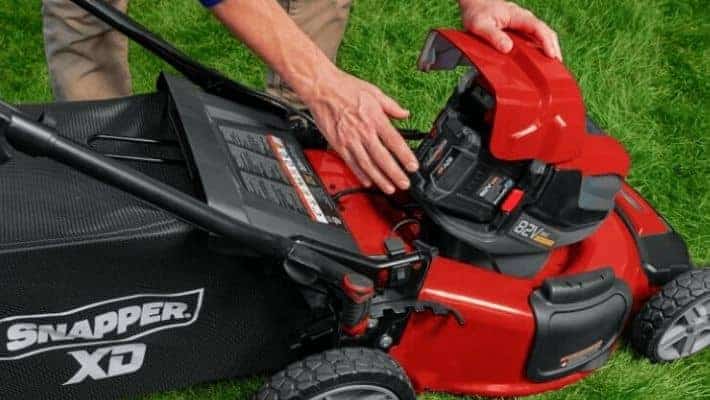Last Updated on March 31, 2024 by Sharaj
Nothing makes your home more beautiful than a well-kept lawn. But every time you think about mowing the lawn, you get frustrations remembering that the mower will produce a lot of noise. Everyone in your neighborhood will know that you are mowing the lawn at home.
If you do this regularly, the neighbors might even complain about the noise.
Most lawn mowers have a noise level of around 90 dB (decibel), an amount of noise that is higher than the noise levels advisable by health professionals for your ears.
You should not expose yourself to this noise level for more than eight hours.
However, lawnmowers differ in their noise levels, but unfortunately, all types are quite noisy. Although there is not much you can do to change the lawnmower’s sound, you can try to purchase a quieter model by reading the manufacturers’ sound label details. It is advisable you also use hearing protection when cutting to protect your hearing.
The lawnmower also has a lot of moving parts and, if something goes wrong, it can make strange noises. The noise it generates may be an indication of the nature of the problem. Common problems that indicate a problem are low vibration, squealing, loud or throbbing sound.
As soon as you hear a strange or incorrect sound, repair the lawnmower to prevent further damage. The guide below will help you understand why your lawnmower is louder than usual and how to make a lawnmower quiet.
How To Make a Lawn Mower Quiet?
Let’s check out why are lawn mowers so loud and how to fix them quickly.
1. Loose Blade Set
The most common reasons for a mower deck making loud noise is from a loose cutting blade set. If the blade assembly is loose, it will move during the initialization process and continue to shake while the cutter is running.
Sometimes, the blade itself can be faulty or bent, making a lot of noise and putting a lot of pressure on the motor shaft. Luckily, you can repair the noisy blade set yourself easily.
How to Fix?
Before putting the cutter aside, disconnect the spark plug and make sure that all switches are off. This precaution ensures that the cutter does not turn on accidentally while looking at the cutting assembly.
Tilt the cutter sideways, take the wrench and check whether the screw holding the blade is tight or not. If the screw appears loose, lock the blade with a piece of wood and turn the screw clockwise until it is tight.
If the cutting assembly is not loose and the screw is tight, you can still hear the vibrations and noise under the cutting deck; the cutting blade is likely making noise.
If the blade is not in balance, with one side heavier than the other, you can use the cutting assembly balancer to balance the blade’s two sides.
If the blade is heavily bent or faulty, you may have to replace it.
2. Accumulation of Grass and Dirt Under The Deck
If you frequently mow wet grass, the debris and grass will eventually accumulate under the cover and the blade itself, leaving little or no space for the lawn, as most of the deck contains the debris and dirt.
This accumulation of grass also causes the blade to curve when it turns, and you can hear the lawnmower making rattling noise under the cover.
You can clean the cover of most lawnmowers with a high-pressure cleaner. However, read the manual that comes with the cutter to confirm that you can clean the cover as per the manufacturer’s guidelines and recommendations.
Disconnect the spark plug cable and tilt the cutter sideways to gain access to the deck. If the mower’s manual says that you can use the water on the deck, use a high-pressure washer to release the grass and any debris on the deck.
If you cannot use water to remove dirt, you can use a scraper to scrape off debris and grass or compressed air to remove dirt. With each method, remove any residue from the cutter and steel cover.
After cleaning, apply the WD-40 to prevent the debris from accumulating back again. Do not apply too much WD-40, as excess lubricant will drip onto the lawn.
3. Faulty Muffler
The muffler’s purpose is to reduce the engine exhaust noise and hence significantly reduce the mower noise.
However, if the muffler is faulty or its attachment to the engine is incorrect, the sounds will not reduce, and you will hear much more noise from the lawnmower engine. Typically, the lawnmower makes a loud clanking sound. You can see damage to the muffler in the form of cracks or holes, while sometimes the muffler does not fit properly at the engine outlet.
Fortunately, most lawnmowers have easily removable mufflers that are relatively inexpensive to replace and install. You can purchase a good muffler for your lawnmower for $ 20-40, and replacing a faulty muffler should significantly reduce engine noise.
As the mufflers are not very costly, it is advisable to replace them instead of repairing them because even if you try to seal the crack or hole, it will come out instantly.
How To Make a Quiet Lawn Mower Muffler?
Replacing the lawnmower muffler is quite simple, and you can do it in a few simple steps. Before starting to replace the muffler, ensure that the engine is not hot. If you were using the lawnmower, we recommend that you wait a few hours before installing the new muffler. Wear protective gloves and turn the muffler anticlockwise to loosen it.
Rotate the muffler until it comes free. Sometimes, the muffler can get stuck due to rust, and you will need a socket wrench to remove it. You can remove most lawnmower mufflers simply by turning them. However, some have an exhaust pipe with a silencer at the end of the pipe.
If the exhaust is faulty, it will also need replacement, which is a little complex than removing the muffler. You may need professional help to prevent damage to the engine.
After removing the faulty muffler, please do not throw it away yet, as you will need to buy a muffler that fits your lawnmower. Then, take an old muffler to the store to look for a similar new muffler to fit your lawnmower. Turning the muffler back on is as easy as removing it.
All you have to do is insert the end of the muffler that has threads into the engine’s exhaust and rotate it clockwise. Keep turning it until it is tight. As soon as you install the new muffler, the mower should run more quietly.
4. Old Engine Oil
Although the lawn mower’s engines are small, they need regular engine oil changes, typically every 30-40 hours of operation or twice a year. Engine oil lubricates several moving parts of the lawnmower engine, and the heat and friction from overtime use can burn oil. After a while, engine oil starts reducing its ability to lubricate the engine properly.
It, therefore, causes the engine moving parts to rub against each other, riding mower grinding sound, making the mower noisier than normal when running, leading to the lawnmower knocking sound.
Let’s check out how to make your lawn mower engine quieter changing engine oil properly:
How to Change Engine Oil
Fortunately, some lawnmowers have a built-in engine oil level alarm that alerts you when you need to change your engine oil. If you have a mower that does not have a low engine oil alarm, you can easily check the mower’s oil level and change it at the beginning of each mowing period and again during the season. The noise will increase, and the oil will darken when the oil is near due time to change.
The lawnmower’s engine will start overheating, as the hot oil can easily escape. Place the pan under the oil filler neck to get the old oil and tilt the cutter with the oil filler cap down directly below the pan’s other side.
Now, remove the oil filler cap while tilting the cutter to the side and let the oil drain for some time. Pour new engine oil into the cutter’s engine and ensure to put the correct amount of oil in the engine. Consult your lawn mower manual for the correct type and amount of oil.
Conclusion
In conclusion, several factors determine the noise that a lawnmower makes. However, the cutter’s engine plays the most important role. Electric, battery, and push-reel cutters also make noise, but of different levels.
As long as the machine has moving parts, you will have to accept the noise. However, you can still reduce the amount of noise by implementing the changes above. Remember to follow the manufacturer’s instructional manual when fixing lawnmower noise issues to avoid damage or injury.
Due to the extreme noise from lawnmowers, most cities have regulations restricting the residents from mowing the lawn at night or early in the morning. If you try to nap on the couch while your neighbor mows the lawn, you find that mowing the lawn can be more annoying than having a group of college students at a party.
The next time you plan to pull the cable to start a noisy lawnmower, make sure to use earplugs to protect your ears. It is also advisable you let your neighbors know that you are mowing your lawn.

